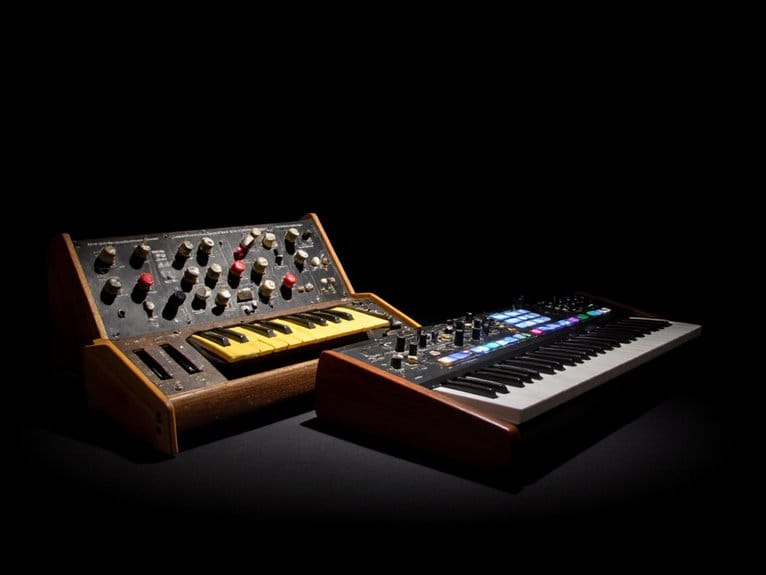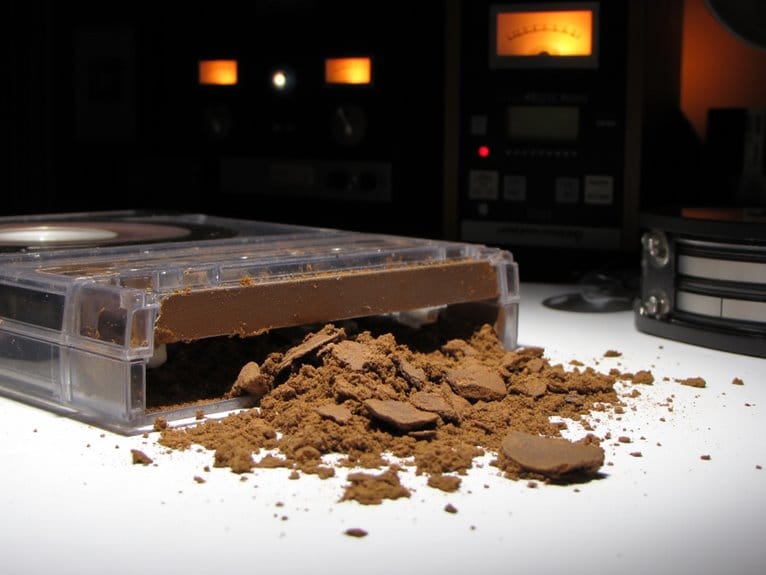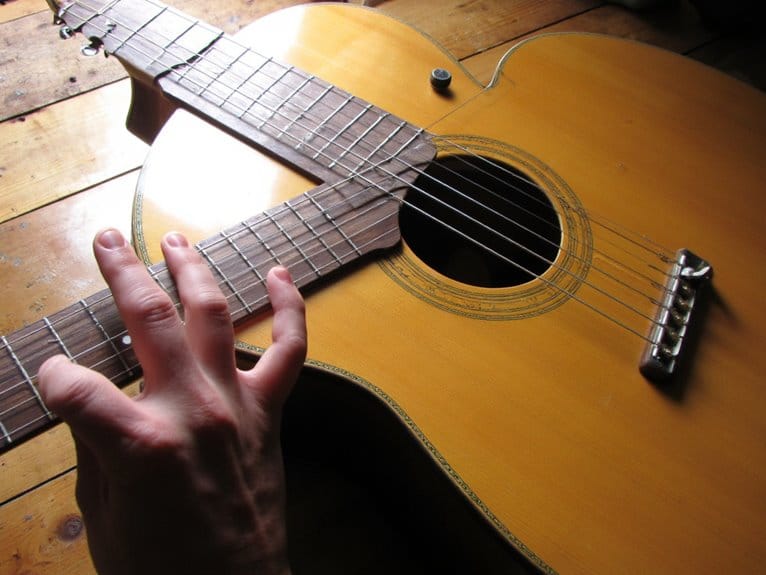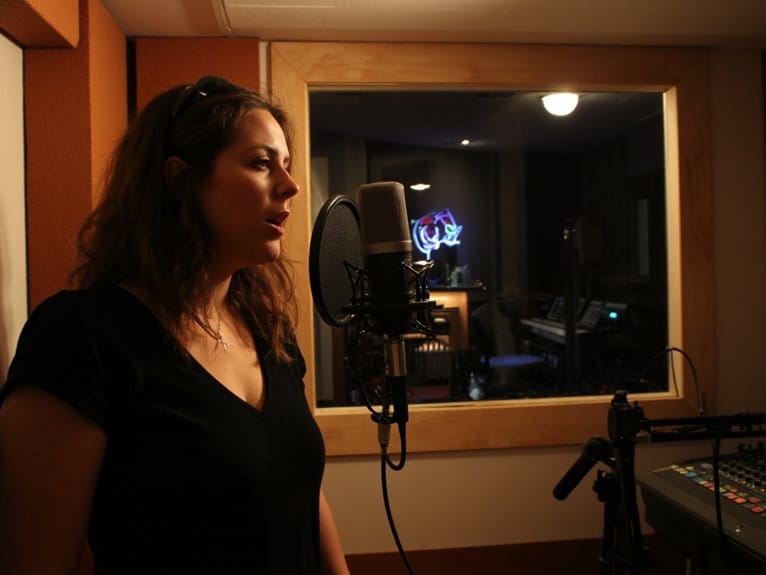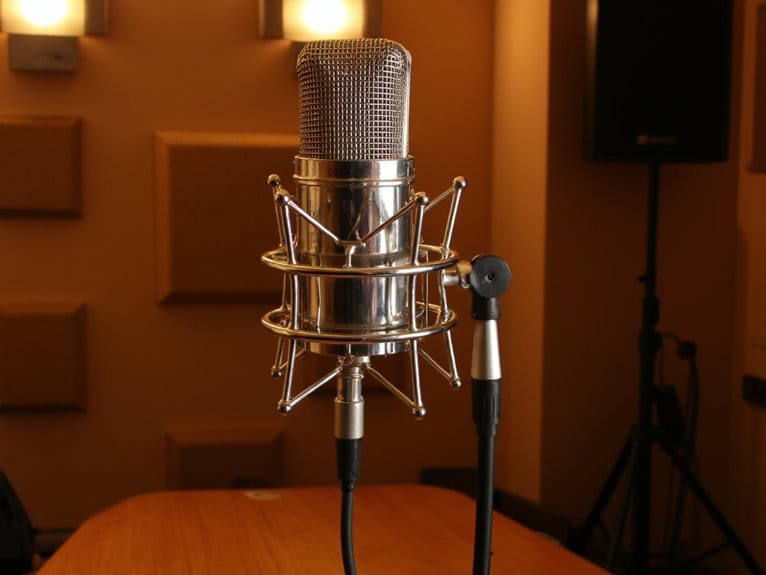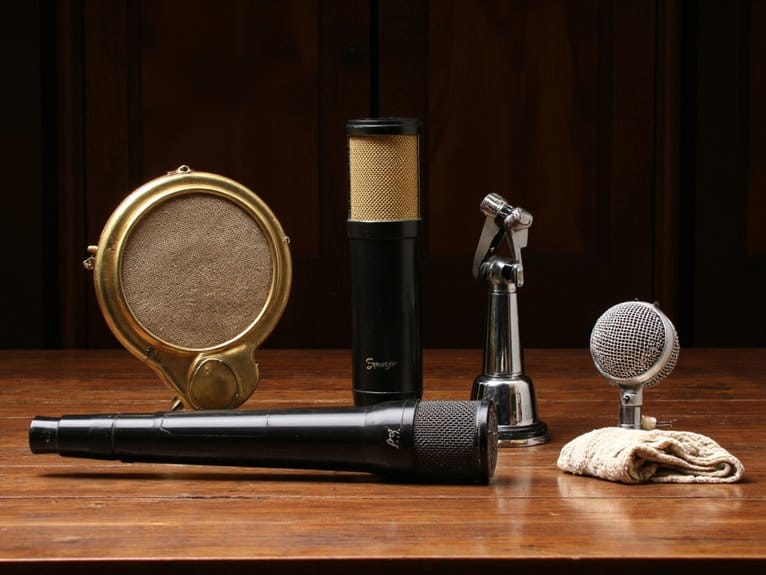Vintage Synthesizer Emulations Vs Modern Designs
You’ll find that vintage synthesizers deliver organic warmth through aging components and harmonic imperfections, while modern emulations offer pristine clarity and enhanced reliability without the maintenance headaches of capacitor degradation and battery leakage. Modern designs provide advanced features like patch memory, built-in effects, and complex modulation routing that vintage units simply can’t match, though they lack the unpredictable sonic character that makes each vintage instrument unique. Below, we’ll explore how these fundamental differences impact your creative workflow and budget considerations.
We are supported by our audience. When you purchase through links on our site, we may earn an affiliate commission, at no extra cost for you. Learn more.
Notable Insights
- Vintage synthesizers offer analog warmth and harmonic richness that modern emulations struggle to replicate authentically.
- Modern synthesizers provide superior reliability and reduced maintenance costs compared to aging vintage hardware components.
- Digital enhancements in modern designs include patch memory, built-in effects, and advanced modulation capabilities unavailable in vintage models.
- Vintage hardware commands premium prices due to rarity, while software emulations offer more accessible and affordable alternatives.
- Component aging in vintage synths creates unique sonic signatures but leads to ongoing repair challenges and ownership expenses.
Sound Character and Tonal Quality Differences
When you’re comparing vintage synthesizers to their modern emulations, the most immediately noticeable difference lies in their fundamental sound character, and I’ve spent countless hours A/B testing these differences in my studio.
Vintage warmth emerges from analog oscillators that drift slightly in pitch and phase, creating subtle harmonic richness through component imperfections and nonlinearities. Modern clarity, while technically superior, often lacks the organic unpredictability that makes vintage synths so compelling.
You’ll notice that vintage filters naturally saturate and distort in musical ways, producing those distinctive “screaming” resonances without additional processing. Digital emulations approximate these characteristics but struggle to replicate the random phase variations and envelope irregularities that give vintage hardware its living, breathing quality. The aging components introduce tuning instabilities and noise that contribute significantly to this organic sonic signature.
Individual vintage synthesizers are selected for specific musical roles based on their unique characteristics, with each model offering distinct tonal personalities that modern emulations struggle to capture authentically.
Reliability and Maintenance Requirements
When you’re comparing vintage synthesizers to their modern counterparts, you’ll quickly discover that reliability becomes a critical factor in your decision-making process. Aging components in classic instruments present ongoing maintenance challenges that can greatly impact both performance and ownership costs.
Your vintage synth’s electrolytic capacitors, tactile switches, and rare proprietary chips fundamentally function as ticking time bombs, requiring constant vigilance and eventual replacement to maintain peak functionality. Battery leakage from alkaline batteries can severely damage printed circuit boards, creating expensive repair scenarios that modern instruments with improved power management systems typically avoid. I’ve learned through years of experience that modern synthesizers typically incorporate more robust, standardized components and better environmental protection, offering you greater long-term reliability with considerably reduced maintenance demands.
Vintage Component Aging Issues
Although vintage synthesizers possess an undeniable sonic charm that’s drawn countless musicians and collectors into their analog embrace, the harsh reality I’ve encountered after years of maintaining these electronic instruments is that aging components create a constant battle against time, reliability, and your wallet.
You’ll face these primary degradation challenges:
- Capacitor degradation – electrolytic caps dry out, causing power smoothing issues and filter instability
- Logic failures – CMOS chips beyond their 20-year lifespan create erratic, hard-to-diagnose glitches
- Mechanical wear – tactile switches double-trigger while sliders produce noise from dust ingress
- Display issues – LCD backlights and VFDs fade, requiring expensive, rare replacement parts
Battery corrosion compounds these problems, permanently damaging circuit board traces and requiring complex repairs that often exceed the instrument’s market value.
Modern Manufacturing Reliability
While vintage synthesizers continue their relentless march toward electronic obsolescence, I’ve discovered that modern synthesizer manufacturing has fundamentally transformed the reliability landscape through standardized production processes, advanced component integration, and thorough quality control protocols that address nearly every pain point I’ve experienced with aging analog gear.
Today’s manufacturers leverage surface-mount technology and integrated circuits designed for mass application, achieving manufacturing tolerances that vintage discrete transistor designs simply couldn’t match. Supply chain validation guarantees authentic, tested components replace the counterfeit parts that plagued earlier production runs.
Automated optical inspection, in-line testing, and contemporary quality protocols eliminate the hand-soldered inconsistencies I’ve battled in vintage units, while modular designs and digital calibration reduce those endless maintenance headaches.
Features and Functionality Comparison
When you’re comparing vintage synthesizers to their modern counterparts, you’ll find that digital enhancement capabilities fundamentally transform how these instruments operate. Contemporary models offer patch memory, built-in effects processing, and MIDI connectivity that simply didn’t exist in the original analog designs.
The interface design philosophy has evolved considerably as well, since modern synths balance the immediate tactile control that made vintage units so appealing with digital conveniences like preset storage, LCD displays, and software integration that streamline your workflow.
I’ve noticed that this blend of old-school hands-on manipulation with contemporary digital features creates a fascinating tension between authenticity and practicality, forcing you to decide whether you prioritize the pure vintage experience or embrace the enhanced functionality that modern technology provides.
Digital Enhancement Capabilities
As someone who’s spent countless hours wrestling with both vintage gear and modern digital workstations, I can tell you that today’s synthesizers offer enhancement capabilities that would’ve seemed like science fiction to the engineers who designed classic analog machines decades ago.
Digital modulation routing lets you assign multiple sources to virtually any parameter simultaneously, while envelope flexibility extends far beyond simple ADSR curves into complex multi-stage territories.
Modern enhancement capabilities include:
- Tempo-synced envelopes that lock perfectly to your DAW’s timeline
- Looping envelope stages creating evolving textures impossible on vintage hardware
- Precise modulation depth control through intuitive software interfaces
- Real-time parameter automation with graphical feedback and randomization features
These digital enhancements transform sound design from tedious knob-twisting sessions into creative exploration.
Interface Design Philosophy
Digital enhancement capabilities represent just one aspect of how modern synthesizers have evolved, but the fundamental philosophy behind how musicians interact with these instruments reveals an even deeper transformation in synthesizer design.
When you’re working with vintage synths, you’ll experience pure knob-per-function layouts that prioritize immediate tactile access, featuring larger, well-spaced controls that encourage spontaneous sound exploration without menu diving.
Modern designs maintain this interface accessibility while cleverly integrating digital displays and expanded interactive controls like ribbon controllers and aftertouch capabilities.
I’ve found that contemporary synths balance retro aesthetic cues with ergonomic improvements, incorporating backlit controls and compact formats that blend vintage simplicity with today’s workflow demands, creating instruments that honor the past while embracing present-day performance requirements.
Emotional and Nostalgic Value Considerations
Beyond the technical specifications and sonic capabilities lies perhaps the most powerful force driving vintage synthesizer appreciation: the profound emotional connection these instruments forge with musicians and listeners alike.
These nostalgic experiences transcend mere sound reproduction, creating deeply personal relationships with music history itself.
Your emotional connections to vintage synths stem from several key elements:
- Tactile memories – Physical knobs and sliders that carry decades of creative fingerprints
- Sonic warmth – Analog imperfections that breathe life into sterile digital perfection
- Cultural narratives – Shared musical histories that connect you to iconic moments
- Personal continuity – Bridges between past musical experiences and present creativity
However, I’ve witnessed countless musicians fall into nostalgia-driven purchasing traps, where romantic idealization overshadows practical considerations, leading to expensive maintenance headaches and buyer’s remorse when reality conflicts with cherished expectations.
Cost and Market Availability Analysis
When examining the financial landscape of vintage synthesizer ownership versus modern alternatives, I’ve observed striking price disparities that fundamentally reshape how musicians approach these iconic sounds. Your price sensitivity will greatly influence whether you pursue original hardware, which commands premium prices due to rarity and collectible status, or embrace modern emulations that deliver comparable results at fractions of the cost.
Market accessibility has improved remarkably with software plugins ranging from free options like OB-Xd to extensive bundles under $400, eliminating the hunting required for vintage units. Digital synthesizers now employ various synthesis methods including subtractive, additive, FM, granular, and wavetable approaches to recreate classic sounds with modern reliability. Budget-conscious producers can now access 4-voice polyphony and professional sound quality through affordable hardware options that previously required significant financial investment.
While I’ve seen original synths demand specialized maintenance and aging components, modern recreations offer consistent availability through established retailers, reliable manufacturer support, and contemporary build quality that reduces long-term ownership expenses considerably. Hardware emulations like the Behringer 2600 GRAY MEANIE demonstrate how manufacturers can deliver authentic analog synthesis at affordable prices, avoiding the substantial costs associated with vintage equipment while maintaining the essential sound characteristics that producers seek.
Sound Design and Creative Potential
While vintage synthesizers might seem limited by today’s standards, their constraints actually open a unique creative gateway that I’ve found consistently inspires more immediate, focused sound design decisions.
When you’re working with vintage emulations, you’ll discover that oscillator slop and minimal layering create signature sounds that modern precision sometimes struggles to match. The wonky envelopes and experimental waveform modulation techniques force creative detours I wouldn’t normally explore.
Consider these vintage-inspired approaches:
- Route single envelopes to multiple destinations for cohesive movement
- Combine ring modulation with pulse width shifts for distinctive timbres
- Embrace phase drift between oscillators for organic variation
- Layer basic waveforms sparingly to maintain recognizable character
Modern designs offer extensive parameters and hybrid synthesis methods, but I’ve noticed they can overwhelm quick creative decisions without disciplined workflow habits.
Frequently Asked Questions
Which Type of Synthesizer Is Better for Beginners Learning Synthesis?
You’ll find modern synths better for learning since they offer workflow simplicity with preset storage and reliable operation. However, if you’ve got strong analog preferences, vintage models provide more direct hands-on parameter control for understanding synthesis fundamentals.
On a final note
You’ll find that choosing between vintage synthesizer emulations and modern designs ultimately depends on your specific needs, budget constraints, and creative goals. While emulations offer nostalgic character and authentic analog warmth at accessible prices, modern synths provide enhanced reliability, expanded functionality, and cutting-edge sound design capabilities. I’d recommend considering your workflow priorities, maintenance tolerance, and whether you’re chasing classic tones or pioneering new sonic territories before making your decision.

